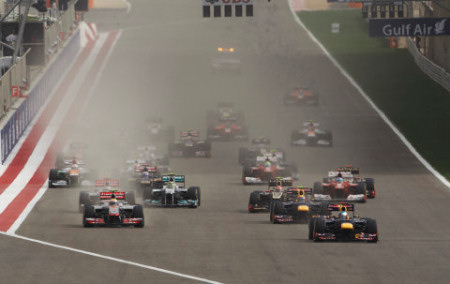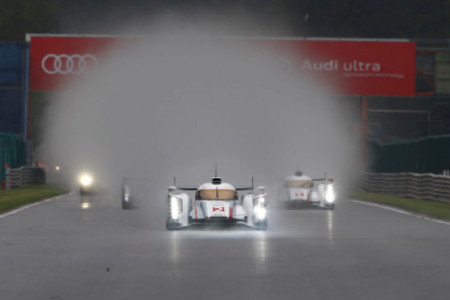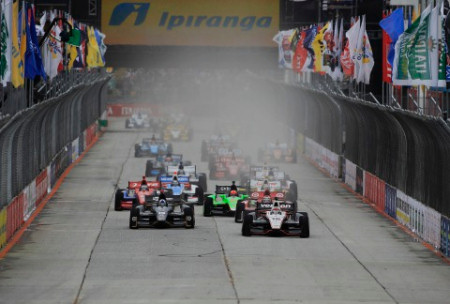The Way It Is/ Auto racing's royal seasonby Gordon Kirby |
 It's May and the height of motor racing's international season has arrived. In the coming weeks we'll watch the world's big three auto races--the Monaco Grand Prix, the Indianapolis 500 and the Le Mans 24 Hours. At this time of year the wider world glances briefly at motor racing and these three races define not only the sport as a whole but also each of their categories--Formula One, Indy cars and long-distance sports car racing.
It's May and the height of motor racing's international season has arrived. In the coming weeks we'll watch the world's big three auto races--the Monaco Grand Prix, the Indianapolis 500 and the Le Mans 24 Hours. At this time of year the wider world glances briefly at motor racing and these three races define not only the sport as a whole but also each of their categories--Formula One, Indy cars and long-distance sports car racing.
Formula One continues to thrive in the most totally self-possessed way of any form of motor sport. F1's octogenarian boss Bernie Ecclestone has driven F1 into a giant moneyball and pushed it into the global market like no other form of racing so that F1 defines racing around the world much like NASCAR defines the sport in the United States. In recent years F1 has expanded into China, Singapore, Malaysia, Bahrain, Abu Dhabi and this year New Delhi--places the traditional F1 fan may not like, but these races provide F1 teams, manufacturers and sponsors with the widest possible reach. If nothing else Ecclestone has responded far better than anyone else in motor racing to the modern age of globalization. Of course, Monaco's Riviera setting and glitz remains the perfect selling point for Formula One, as it has for many years. Historically the race is exceeded only by the French, Italian and Belgian GPs, but it's long been considered the crown jewel of Grand Prix racing. The track is not much changed over the years and continues with minimal run-off or room for error and much more elevation change than most street circuits. Watching an F1 car scything between the curbs and guardrails at Monaco remains one of the most impressive sights in motor sport.  © LAT USA Still, F1 cars are spectacular to watch and hear in action. They make a tremendous amount of noise--truly ear-shattering--and respond sharply to throttle, brake and steering input. They're a pleasure to watch and clearly take a lot of skill to drive on the limit. This year F1 is enjoying its most competitive season in some time with five different drivers and teams winning the opening five races. Kimi Raikonnen has rejoined F1 with the rejuvenated Lotus-Renault team so that there is six world champions in the field, all driving for contending teams. Red Bull's advantage from last year has vanished and plenty of other teams are looking good including McLaren, Ferrari, Lotus, Mercedes and Williams. Pastor Maldonado's surprising victory for Williams in Spain last weekend was the team's first win in eight years and Maldonado joined Nico Rosberg as the year's second first-time winner. At this point both the drivers and constructors championships are wide-open. At the end of the year F1 will make a fresh start in the United States at the Circuit of the Americas in Austin and next year the Weehawken GP springs to life in New Jersey just across the Hudson River from Manhattan. Thus will F1 try to re-establish itself in the United States. F1 is always portrayed as the pinnacle of the sport but that principle is under challenge these days because of the increasingly restrictive nature of F1's rules. In fact Le Mans-type sports car racing has emerged in recent years as a more technically intriguing form of motor sport than F1 with the appearance of Audi and Peugeot turbo diesels and a variety of different hybrids from Porsche, Zytek and others. Over the last two years Porsche successfully developed and raced its 911 GT3 R Hybrid and this year Audi will race two new 'e-tron quattro' R18 hybrids at Le Mans beside a pair of more traditional R18 Ultras. The new hybrid Audi has a KERS-like flywheel system similar to the 911 GT3 R system. Developed by Williams the Audi system provides power to the front wheels making the car 4WD. One of two 4WD 'e-tron quattros' qualified on the pole and finished second in the car's debut at the Spa 1000Ks the week before last as Audi swept the top four places. With the choice of more power or better fuel mileage from its flywheel hybrid system the latest monster from Audi has a serious shot of winning Le Mans this year. If rain arrives during the race it will only improve the chances of the 4WD 'e-tron quattro'. Toyota has also built a hybrid LMP1 car for this year's Le Mans 24 Hours. Type-numbered the TS030, the car was wrecked in recent testing so it didn't race at Spa and will have to make its competition debut at Le Mans. The Toyota hybrid is powered by a conventional petrol-powered 3.4 liter V8 mated to a storage battery and a capacitor-based distribution system roughly similar to the company's production car hybrid technology.  © LAT USA Many of us look forward to the Delta Wing's debut at Le Mans and we hope to see the car racing in America later this year in some ALMS races. With a little luck and some hard work we may see a fleet of Panoz-built Delta Wings racing regularly in the ALMS next year. Meanwhile IndyCar and the Indy 500 is at a crossroads this year. A new one-make formula has been introduced with competing engine manufacturers but very restricted technology and little room for development. IndyCar has chosen to continue pursuing NASCAR's path of fiddling with the rules to 'level the playing field' as we've seen in recent weeks with Chevrolet's dispute with IndyCar about permitting Honda's single turbo a little more breathing room. A week or so ago Chip Ganassi's IndyCar and Grand-Am general manager Mike Hull wrote that the new car and formula, "is more spec and controlled than the one it just replaced." Hull is a renowned opponent of spec cars but he now finds himself trying to accept and defend IndyCar's right to pursue this approach to motor racing. I can only assure Hull's many fans that his vociferously critical off-the-record comments to me this winter and spring about the DW12 program do not reflect his understandably pragmatic public position. Almost all the readers of both this column and Motor Sport magazine believe IndyCar must open up its rulebook to multiple car builders in 2015. They believe an open, competitive market is one of the sport's driving forces as it always has been and continues to be in F1 and sports car racing. After all, even NASCAR allows its teams to build their own chassis. It's also essential to encourage the American race car industry to re-engage in Indy car racing and to open up the rules to permit the new age of automotive innovation characterized by KERS and hybrid systems not to mention the Delta Wing. IndyCar has fallen behind technically and is in danger of being left behind in the technological dust. Many of us believe IndyCar must break away from its spec car mentality and recast the sport on its original foundation. Fans across the country and around the world are crying out for it. Meanwhile, despite his best efforts Randy Bernard has discovered he's facing a tough task trying to rebuild IndyCar's schedule into a good mix of solid, crowd-pulling oval, street and road races. Generating successful IndyCar oval races is a major problem and as everyone knows there are only four ovals on IndyCar's schedule this year. Next year IndyCar will return to a street circuit in Houston and probably to Elkhart Lake too while there's also a chance of returning to Phoenix, once an IndyCar stronghold. Things are looking good for Team Penske in IndyCar this year with Will Power winning three of the first four races and Helio Castroneves taking the other. Penske appears to have sorted out the DW12 better than most teams and the twin turbo Chevrolet V6 also appears to enjoy a small performance advantage over the competition from Honda and Lotus/Judd. Going into practice and qualifying at the Speedway Roger's team is the favorite to win its 16th Indy 500 and 13th USAC/CART/IRL/IndyCar title.  © LAT USA IndyCar's lingering, underyling problem is not having a major TV contract with a serious rights fee and plenty of mainstream coverage which is the driving force behind modern F1, NASCAR and every other major professional and amateur sport. Over the course of many years of political squabbling CART, Champ Car and IndyCar collectively missed the boat on earning major income from TV and providing Indy car racing with plenty of exposure. Bernie Ecclestone and Bill France Jr.--and every other major sports mogul--focused their minds on building their TV exposure and rights fees but over many decades the powers-that-be in Indy car racing dropped the ball making the way forward long and difficult. Today Indy car racing is consigned to the margins as a minor league sport with tiny TV ratings and little or no leverage to generate much TV income. There's hardly any TV money for the teams and not enough exposure for most them to be able to sell major sponsorship. It's a vicious circle. In closing, a few observations from Parnelli Jones one of America's greatest drivers from the sixties and a very successful Indy car team owner through the seventies. "It was a lot more interesting when you had a lot of different people building cars and engines," Jones remarked. "But you can't turn the clock back. Other than the danger factor, we raced in the best of times. It was much more creative and interesting. "They're trying with the different engines this year and I think they've done a lot of good from the safety standpoint with the new car. However, I think it has more downforce and that exaggerates a lot of the problems you had in the first place with guys being able to flat-foot the car around a place like Vegas. When you put more ground-effect on there, which I understand this new car has, you just exaggerate that problem. They need to make the cars so you have to back off at Indy and these high-banked stock car tracks. "Rather than running on these tracks that were built for stock cars they're better off to stick to more road racing and street racing. NASCAR is struggling with these cookie-cutter, mile-and-a-half banked ovals. I think they've realized they don't want to build any more tracks like that. And the other thing is there are so many different sports and entertainment-type things to compete against today. It's a tough market out there, especially when the economy is not the best." Everyone hopes for a safe, clean few weeks at the Speedway and a good first 500 for the new car and formula. Despite the web of problems an abundant supply of young drivers from around the world and committed team owners remain eager to race Indy cars. All of us would like to believe that come the 100th running of the 500 in 2016 Indy car racing will have rediscovered its mojo and be in a position to begin to enjoy the fruits of a longterm climb in appeal and popularity. |
Auto Racing ~ Gordon Kirby Copyright 2012 ~ All Rights Reserved |
